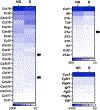Dysregulated inflammatory response to urogynecologic meshes in women with diabetes and its implications
- PMID: 38408622
- PMCID: PMC11194151
- DOI: 10.1016/j.ajog.2024.02.282
Dysregulated inflammatory response to urogynecologic meshes in women with diabetes and its implications
Abstract
Background: Diabetes is an independent risk factor for mesh complications in women undergoing mesh-augmented surgical repairs of stress urinary incontinence and/or pelvic organ prolapse. The underlying mechanism remains unclear.
Objective: This study aimed to define the diabetes-associated alterations in the host inflammatory response to mesh and correlate them with perioperative glucose management.
Study design: Deidentified demographics and medical records of patients who underwent mesh removal and participated in a mesh biorepository study were reviewed (n=200). In patients with diagnosed diabetes (n=25), blood glucose management before initial mesh implantation and before and after mesh removal was assessed by blood glucose and hemoglobin A1c levels. Age- and body mass index-matched tissue samples excised from patients with and without diabetes were examined. Transcriptomic profiles of immune cell markers, immune mediators, key inflammatory regulators, cell senescence, and epigenetic enzymes were determined by multiplex transcriptomic assays (NanoString). Ratios of apoptotic cells to CD68+ macrophages were examined with immunofluorescence. Protein profiles of 12 molecules involved in apoptotic cell clearance were examined with a multiplex protein assay (Luminex).
Results: Demographic and clinical characteristics, including duration between mesh implantation and removal, reason for removal, and type of mesh, etc., were comparable between patients with and without diabetes, except for 11.6% higher body mass index in the former (P=.005). In patients with diabetes, suboptimal management of blood glucose following mesh implantation was observed, with 59% of the patients having loosely or poorly controlled glucose before and after the mesh removal. Ongoing chronic inflammatory response was observed in the excised mesh-tissue complexes in both groups, whereas markers for M2 macrophages (Mrc1 [mannose receptor C-type 1]) and helper T cells (Cd4 [CD4 molecule]) were increasingly expressed in the diabetic vs nondiabetic group (P=.023 and .047, respectively). Furthermore, the gene expressions of proinflammatory Ccl24 (C-C motif chemokine ligand 24) and Ccl13 (C-C motif chemokine ligand 13) were upregulated by 1.5- and 1.8-fold (P=.035 and .027, respectively), whereas that of Il1a (interleukin 1 alpha) was paradoxically downregulated by 2.2-fold (P=.037) in the diabetic vs nondiabetic group. Interestingly, strong positive correlations were found between the expression of Ccl13, Setdb2 (SET domain bifurcated histone lysine methyltransferase 2), and M2 macrophage markers, and between the expression of Il1a, Fosl1 (activator protein-1 transcription factor subunit), and dendritic cell markers, suggesting the involvement of macrophages and dendritic cells in the diabetes-dysregulated proinflammatory response. Supportively, apoptotic cell clearance, which is an important function of macrophages, appeared to be impaired in the diabetic group, with a significantly increased protein level of CALR (calreticulin), an "eat-me" signal on the surface of apoptotic cells (P=.031), along with an increase of AXL (AXL receptor tyrosine kinase) (P=.030), which mediates apoptotic cell clearance.
Conclusion: Diabetes was associated with altered long-term inflammatory response in complicated mesh implantation, particularly involving innate immune cell dysfunction. Suboptimal blood glycemic control following mesh implantation may contribute to this immune dysregulation, necessitating further mechanistic studies.
Keywords: apoptotic cell clearance; blood glucose management; cell senescence; dendritic cell; epigenetics; macrophage; proinflammatory cytokines/chemokines.
Copyright © 2024 Elsevier Inc. All rights reserved.
Conflict of interest statement
The authors report no conflicts of interest.
Figures




Similar articles
-
Surgery for women with pelvic organ prolapse with or without stress urinary incontinence.Cochrane Database Syst Rev. 2018 Aug 19;8(8):CD013108. doi: 10.1002/14651858.CD013108. Cochrane Database Syst Rev. 2018. PMID: 30121956 Free PMC article.
-
Surgical management of pelvic organ prolapse in women.Cochrane Database Syst Rev. 2010 Apr 14;(4):CD004014. doi: 10.1002/14651858.CD004014.pub4. Cochrane Database Syst Rev. 2010. Update in: Cochrane Database Syst Rev. 2013 Apr 30;(4):CD004014. doi: 10.1002/14651858.CD004014.pub5. PMID: 20393938 Updated.
-
Transvaginal mesh or grafts compared with native tissue repair for vaginal prolapse.Cochrane Database Syst Rev. 2016 Feb 9;2(2):CD012079. doi: 10.1002/14651858.CD012079. Cochrane Database Syst Rev. 2016. Update in: Cochrane Database Syst Rev. 2024 Mar 13;3:CD012079. doi: 10.1002/14651858.CD012079.pub2. PMID: 26858090 Free PMC article. Updated.
-
Surgery for women with posterior compartment prolapse.Cochrane Database Syst Rev. 2018 Mar 5;3(3):CD012975. doi: 10.1002/14651858.CD012975. Cochrane Database Syst Rev. 2018. PMID: 29502352 Free PMC article.
-
Systemic pharmacological treatments for chronic plaque psoriasis: a network meta-analysis.Cochrane Database Syst Rev. 2021 Apr 19;4(4):CD011535. doi: 10.1002/14651858.CD011535.pub4. Cochrane Database Syst Rev. 2021. Update in: Cochrane Database Syst Rev. 2022 May 23;5:CD011535. doi: 10.1002/14651858.CD011535.pub5. PMID: 33871055 Free PMC article. Updated.
Cited by
-
Cytokine modulation in pelvic organ prolapse and urinary incontinence: from molecular insights to therapeutic targets.Mol Med. 2024 Nov 13;30(1):214. doi: 10.1186/s10020-024-00989-3. Mol Med. 2024. PMID: 39538179 Free PMC article. Review.
References
-
- Women’s Health USA 2013. https://mchb.hrsa.gov/sites/default/files/mchb/data-research/womens-heal....
Publication types
MeSH terms
Substances
Grants and funding
LinkOut - more resources
Full Text Sources
Medical
Research Materials
Miscellaneous

